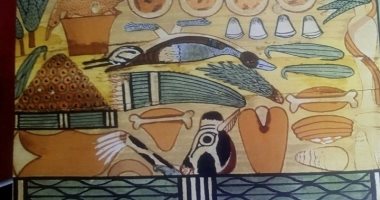Hetep de Nsou .. Find out about the list of Pharaohs, fish, goose, perfume, incense and vodka

The faith in the resurrection and other life after death was the primary motivation for the Pharaohs to offer kings and individuals to offer offerings to their dead, whether through written texts or scenes and engravings inscribed in their tombs or through the placing of offerings and funerary equipment in their graves. To learn more about offerings, With archaeologist Dr. Hussein Abdel Basir, director of the Bibliotheca Alexandrina Museum to learn more about the subject.
Dr. Hussein Abdel Bazir said that there was a famous formula known as the offering formula or Hattab de Nisu, a sacrifice offered by the king in the ancient Egyptian language. It was often composed of a specific set of words that can be read through actual reading of the soul of the deceased through Activation of the magic value of the word, which is already transformed into real offerings based on the ancient Egyptian belief in the power and effectiveness of the word by reciting and reciting the magical spells.
Dr. Hussein Abdul Basir explained that the formula of offering offerings was usually written in hieroglyphic script, and hoped that the actual offerings of the dead would be presented, such as offering many types of food, drinks, supplies and the needs needed by the deceased in the other world or from the Jalal recitation of the form of offerings with all its contents. Various kinds of offerings of various kinds, as well as the depiction of the sacrifices offered to the deceased in the form of scenes or inscriptions, and was expressed in art or through the expression of written texts through the use of hieroglyphics in achieving that purpose.
Dr. Hussein Abdel-Basir said that it would be preferable to place the actual sacrifices in the graves in the place of burial, which was provided to the deceased by some members of the family such as the son or the role of heir to the deceased or some of the parents who visited the cemetery, Or by some of those passing through the deceased's grave, or seeing or reading his own funerary painting.
He pointed out that the formula of offering offerings usually begins with the following line: "The offering given by the king and the minister, the great God, the master of Abydos." The name of the soul of the deceased who is offering offerings is then mentioned. He was the owner of the graveyard or painting who looked eagerly and breathed his soul to receive these offerings In the world of the Hereafter, and then the formula of offerings in the recitation continues, "Perhaps a sacrifice made of bread, beer, oxen, birds, alabaster, linen, and everything good and pure will be offered by God."
He pointed out that some of the formulas mentioned names or types not in the traditional forms of offerings such as "oils or aromatic fats, incense, offerings, supplies and needs", which was also included in the list of offerings to the deceased, there are some strange species of offerings in the offerings, "And geese, fish and falcons, within the table of offerings in one of the scenes of a tomb of the era of the old state.
The director of the Archeology Museum of the Library of Alexandria said that the offerings were also presented to the gods. The kings or their representatives, such as the high priest or his representative, performed the offerings on the tables of the Egyptian gods inside the Egyptian temples. Offering offerings and constant supply of gods and temples.
In these customs, we are reminded of the visit of the dead in contemporary Egypt, the reading of the Fatihah and the Koran for their souls, and the offering of "mercy and light" to their souls for the poor and needy after the burial. On Thursday and Wednesday, and on holidays and anniversaries, ancient Egypt did not die.
.
Post a Comment